I need to boast about a monster achievement... I have been ignoring my blog for a long time, and here is one of the reasons why: my shiny new book just delivered ! I think this must be the first picture book illustrated in egg tempera since the Middle Ages. It is a bi-lingual story (English/German parallel text) for children of all ages. The Monster of Millstatt is a thirty-foot scarlet dragon who has been hibernating for a few hundred years in the mountains behind my house. When he finally emerges from his den he goes on the rampage and creates a load of comical trouble for the locals round the lake, till he is finally brought to heel and instated as a member of the community. The text and illustrations are all my own, though naturally I had a deal of help with the German. British humour is not easy to translate, it seems. The whole idea first grew out of a school cultural project frustrated by Corona restrictions. I thought it was a shame to waste a good idea, but it took over my life. I'm not a fast worker, and I quickly gave up counting the hundreds of hours spent on the pictures. Then when I realised that hiring a graphic designer to help with the layout was unaffordable, I had to set about learning all the software skills to do it myself. As for the printing, since I first approached printers for a quotation, costs have risen exponentially thanks to a world paper shortage. Reader, be warned! If ever the fancy should come over you to produce a book, have a little lie down and let the feeling wear off. Now comes the work of shipping 500 copies out of my cellar and on to the coffee tables of Carinthia - not a small task for a sales-shy artist operating in a foreign language. But I think that luckily the book has appeal both for locals and tourists - a souvenir with local flavour which is neither kitsch nor too heavy to pack in a suitcase. And the book has already been adopted as an event in the Millstatt Music Festival for next summer - a reading with musical interludes, along the lines of Peter & the Wolf, orTthe Carnival of the Animals. Local music director Stefan Hofer will compose the music:, and I am so looking forward to hearing what comes - my only stipulation was that he must include bagpipes and alpine horns, Fortunately he has both those instruments at his disposal. -Millstatt has everything.
Copies available direct from me at €20 each (order form here).
I must also give a fanfare to the twelve students who attended my beginner's course in manuscript illumination and produced some amazing work. Very steady hands all, even the youngest attendee who was only eleven. Mainly dragons, but also a stray snake and a floreated initial, the students' own design. Sadly a tech failure meant that I lost most of the photographs I took at the second session but I have a few from the first, anonymous by request.
 Romanesque church of St Caecilia, Cologne. Now the Schnuetgen Museum of Medieval Art Romanesque church of St Caecilia, Cologne. Now the Schnuetgen Museum of Medieval Art ermany has a tradition of carved religious statuary unbroken from the early middle ages, so was not surprised that this art form dominated the lovely Schuetgen Museum in Cologne: it is a private collection, donated to the city, and perfectly housed in Romanesque church building. I had the place almost to myself, and could walk round all the exhibits and examine them from near and far to my heart's content, only slightly inhibited by the hovering of the museum guardian who, having no one else to keep an eye on, and presumably having long since exhausted the novelty of the exhibits, trailed me round like my own personal minder. I remarked hintfully that he must find the work very dull but he shrugged and said, "Ein Job ist ein Job". Looking over the photographs I took, I feel provoked to get on the soapbox for one of my rants. Will somebody please tell me how in the world we got from this:- A 12th C carved wooden corpus (polychrome, but paint now eroded) in Schnuetgen Museum Cologne. - to this? - And this? The local talentPeople, have we all gone blind? Is this a proper focus for prayer and meditation? Why are we confronted every Sunday by this kind of ubiquitous glassy-eyed tat? Is it because The Committee would rather buy something out of a supplier's catalogue than risk dealing with a real live artist? There are people who make a living out of restoring these plaster statues - it shouldn't be allowed! When I am dictator of the world we will consign all the hideous pious paraphernalia to the cemetery and commssion some real artists. Even if it's not world class it will surely be more honest and expressive than what we've got now. There is a Facebook Group entitled "I'm fed up with bad church music". I propose a sister act entitled "We're sick of tacky church art", I have worked myself up into such a passion now that I can only append, without further invidious comparison, a sample of the other magnificent Christian art on display at the Schnutgen Museum.
 As a child visiting my grandparents, I used to love poring over their twelve volumes of Arthur Mee's Children's Encyclopedia. A wonderful work, in print for an incredible sixty years from the early 1900s! Among the many anachronistic treasures to be found therein were photographs of the great North European cathedrals taken before the terrible destruction visited on so many of them during the second world war. I had them in mind on my recent visit to Cologne in Germany, home of the famous Koelnisch Wasser ('4711' as it's known - my grandmother had a covetably dinky little bottle of it sitting on her dressing table). Cologne, always important for its strategic trading position on the Rhine, is now a modernised industrial city famous for its crazy Easter carnival which lasts six months and for having being bombed to blazes during the war. But happily there are some surviving golden nuggets for the medieval art enthusiast to mine. Most well-known of them is the cathedral, whose blackened twin towers rise into the sky as a testament to the Koelner tenacity and determination to rebuild it from the ruins. The citizens set about the task of rebuilding almost immediately after the war, and work continues to this day. The cathedral houses a magnificent golden shrine to the Magi whose reputed mortal remains have been here since the early twelfth century. I wish I could have got closer to the reliquary, because it is an artwork almost worthy of reverence in itself, made by the incomparable medieval goldsmith Nicholas of Verdun. Instead I lit a candle for a precious family friend whose death we heard of while we were away, and thought of the beautiful Poulenc motet he and I used to sing in the church choir, 'Videntes stellam': teeth-jarringly beautiful dissonances in the second soprano line. "Seeing the star, the wise men were overwhelmed with great joy;and entering the dwelling, they offered to the Lord gold, frankincense, and myrrh. The day of my visit a great deal of noisy pavement construction was going on, and the ambulatory was occupied by a mini-crane with a woman bravely perched thirty or forty feet up in the bucket, dusting a polychrome archbishop with paint brush and vacuum. She noticed me taking the photograph and shot me an old-fashioned look, which is my excuse for the lack of focus. Unfortunately most of my pictures of the interior were either too blurred or too dark to be worth publishing. The second photo below was intended to show the interesting painted gothic beam, looking as if it were originally part of a rood screen - but instead the modern mosaics below the clerestory show up much better. The third grainy photo is of a painted stone side altar which caught my eye, partly for the green and red colour interchange which I love so much and seems so characteristic of gothic art. Also in Cologne I found the Schnuetgen Museum, a cave of medieval treasures - more to follow soon!
I was hard put to it to decide which beautiful picture to use as an illustration of my recent visit to this exhibition and eventually decided on this page from a Latin Kingdom of Jersusalem sacramentary, dated around 1128. I love it for the east-meets-west style of the icon panel, and the beautiful versal script. I am learning how to write versals at the moment, this is definitely one to add to the study list.
A must-go exhibition for iconographers, illuminators and scribes - on till December, so don't miss. Many of the manuscripts are in cases of course, giving the usual difficulty for close examination, but there are many cuttings framed on the wall which one can eyeball closely. There are also handy reference copies of the £30 exhibition catalogue lying everywhere, which means one can examine photographs and read up on detail without expense. Give yourself a good couple of hours and try to get there early before the usual headphone brigade are there blocking the view! Many of the manuscripts are from the University collection, but there are also borrowings from the British Library, the Archbishop of Canterbury's Library and elsewhere. The later medieval and early Renaissance period is quite heavily represented, as one might expect. The show's chief focus is on the chemistry and provenance of pigments and materials used in book illumination but technique is also touched on. Iconographers will be interested to study the gradual development of different fleshpainting techniques, from the fully modelled style of the Byzantine period through to western experiments with pointillism, grisaille and tinted drawing. Other random gleanings that I shall follow up on my next trip: - Different ways of ruling the page: pricking, hardpoint, silverpoint, plummet. Medieval readers preferred their pages to be ruled and even drew in guidelines to the first printed books because the page looked naked without! So this business in calligraphy class about not showing the lines is a load of rubbish, ha! - Using black gesso under gilding for special effect. Must try, could look amazingly contemporary. - Indigo and woad are chemically indistinguishable when used as dyes or pigments. Western artists probably used woad. It will grow in the back garden, and I found someone on line who extracts and sells the pigment. - The fabled Tyrian purple, so expensive, was extracted from North Atlantic dogwhelks as well as from the Mediterranean murex. The farthest Scottish islands had a trade in it. On the other hand there was a cheap subsitute to be made from the turnsole plant or a variety of lichen, used on some of those glorious purple-dyed manuscripts. - Some French manuscript fragments c 1250 were described as having a 'stained glass palette', an artistic cross-fertilisation from the contemporaneous technological developments in coloured glass (remember that amazing Chartres Cathedral blue?). One of the pigments used was minium. I have always held off using minium (red lead) on the grounds of it being so toxic, but I suppose that's a bit daft given that I already use vermilion (mercury), white lead (for gesso) and the cadmiums. I am interested in this manuscript school, and up till now have had to guess at what pigments were used to achieve the effect. This is a not-to-be-missed opportunity to see illuminated treasures from many centuries and cultures at the Fitzwilliam Museum in Cambridge. Fortunately there is plenty of time, as the exhibition runs from 30 July to December this year. It is entitled Colour: the art and science of illuminated manuscripts, and is part of the university's manuscript research and cataloguing project that has been going on for some years now. Cambridge University as a whole has a magnificent collection of illuminated manuscripts scattered through the college and University libraries, but unless you are a senior university member or can offer bona fides from a serious academic institution elsewhere you are unlikely to get a chance to handle and really be intimate with any of the great treasures. Looking at them dimly lit behind glass is frankly not the same, but is still a wonderful opportunity for study, if only to realise how very tiny much of the work is. Reproductions in books tend to be very much enlarged, and one gets no sense of the absolutely diminutive scale these artists worked on. Either serious myopia was a job requirement and these artists were blind as moles more than six inches from their noses (as I am myself) or else magnifying eyewear was more common in the middle ages than is generally thought. Someone ought to make a study of the role of myopia in art - I'm convinced it must have played a part in Impressionism as well.
I'm not sure I made the right decision with my membership of the Society of Feline Artists. I love cats but the art-buying public seems not to, or at least not so much as they do birds - and one must be just a teeny weeny bit commercial. I had fun getting together my offering for this year's show at Llewellyn Alexander Gallery in London though: it's not till August but it's as well to get ahead. Just sorting out the framing is a mission in itself, especially for the vellum pieces. I am pleased how small I am managing to paint on the vellum. Not up to medieval standards of miniature yet, but getting there. My considerable myopia makes it possible to see in splendid magnification an inch from my nose, but nevertheless every time I see a manuscript illumination I am astonished again at how tiny the detail is. Were all those artists really that shortsighted or were magnifiers more widespread than we think? These daubs of mine are just over three inches square: much smaller and they might not be visible on a wall, I suppose. Ideal for minimalists and owners of the new 'bijoux' style of property!
|
The view from my deskCurrent work, places and events, art travel, and interesting snippets about Christian icons, medieval art, manuscript illumination, egg tempera,, gilding, technique and materials. Categories
All
Archives
January 2024
|

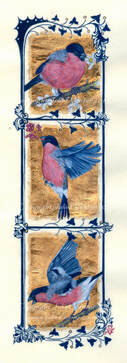




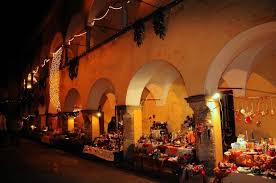



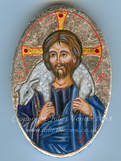









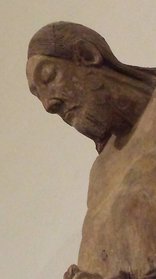
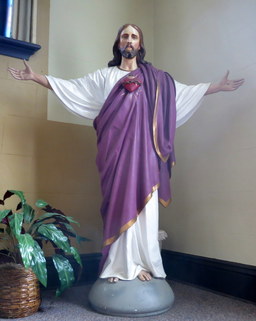










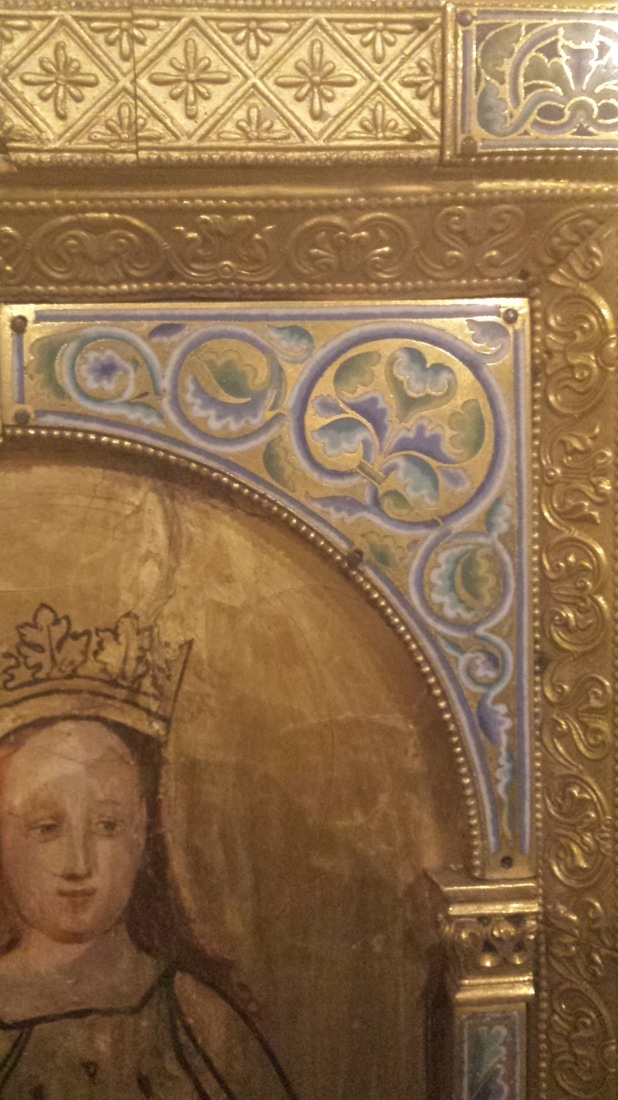






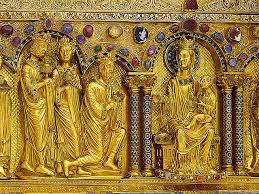







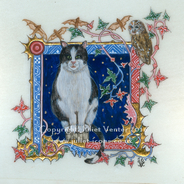

 RSS Feed
RSS Feed